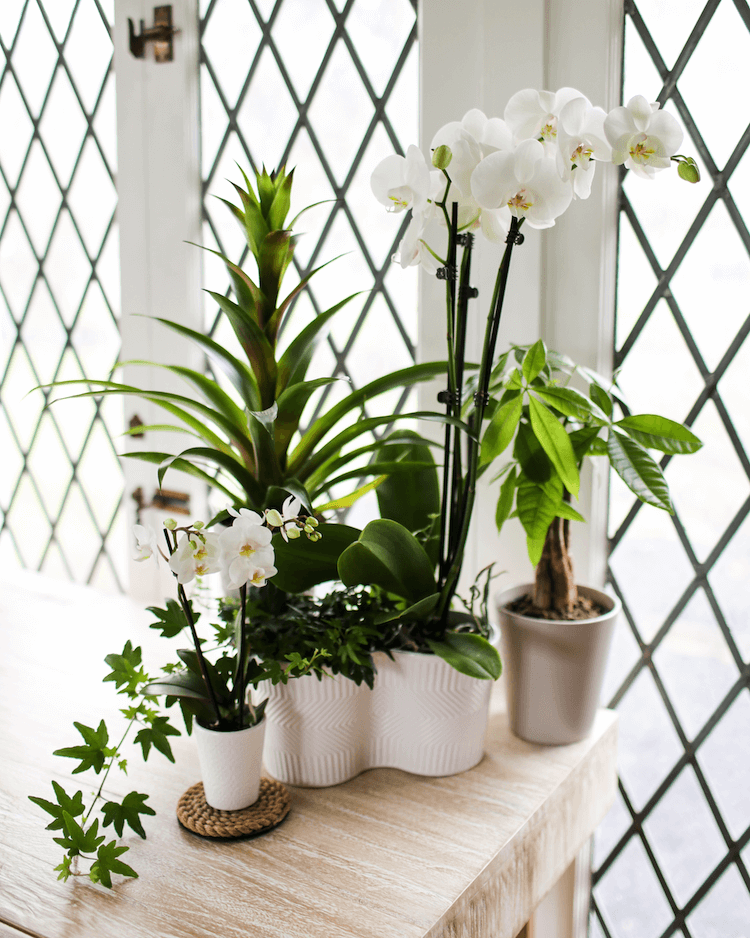
Winter can be a stressful season for plant lovers! With less light and colder temperatures, it can be stressful to continue to give your plants what they need and ensure that they’re being supported.
Whether you’re nurturing your first orchid or are a longtime orchid lover, the winter months can be a bit concerning. You might not know how to help your tropical-temperature-loving plant through the driest, coldest time of year. No worries: you can help your orchid thrive until spring and beyond just by following these simple steps.
Here are five winter orchid care tips that will help both beginners and pros navigate the next few months.
Depending on the climate where you live and the dryness of your home, you may need to adjust your orchid watering routine. While three ice cubes per week is the standard, dry heat can make your orchid dry out faster and require a little extra moisture.
Make sure you give your plant a few weeks to adjust once you switch the heater on regularly, your plant will give you signs that it needs more water once it’s had some time to acclimate to the drier space.
However, the dangers of overwatering should not be taken lightly, so be mindful of how you approach this challenge. The best clue is to look at your plant’s roots. A well-watered orchid has plump, green roots. If you notice your orchid’s roots start to dry out, you may want to adjust the water routine slightly to give your plant the added moisture it needs.
If you keep your orchid inside, the temperature shouldn’t be a problem during the winter months. However, since orchids love humidity and winter is a dry time of year, you may need to pay close attention to your home’s humidity levels.
Make a humidity tray by placing your plant on a shallow tray filled with pebbles and water
Run a humidifier for a few hours each day in the same room as your orchid
Keep your orchid in the bathroom during the winter months. Just make sure it gets enough natural light!
And speaking of light…
Winter days are shorter and generally less sunny, so you may need to rethink the location of your orchid for a few months. Make sure you find a spot that receives lots of indirect natural light for the happiest, healthiest plant. If you don’t have a place in your home that offers enough light, or you live in an area that is cloudier during the cooler months, there is no harm in supplementing light with a grow light until spring!
To avoid sunburn, keep your plant in a north- or east-facing window, away from direct sun exposure. If you’re keeping your orchid in a room with south-facing windows, make sure it’s out of direct light but still in a spot that receives plenty of sunlight.
The warm, dry air coming out of your vents to heat your home can pose a danger to your orchid. If your plant is in the path of a vent, consider relocating it. Similarly, you don’t want to put your orchid near a doorway that will be frequently opened and could bring in outside drafts.
We know this can be tough to find a spot that meets these needs, but drafts will impact your plant’s growth. If you must choose between good lighting and a draft, choose moving the plant away from the draft, you can always supplement lighting.
If you notice your orchid's buds falling off, there's a good chance you're exposing it to a draft.
While yellowed leaves are a sign your orchid needs you to act, they aren’t anything to panic about. Generally, yellowed leaves mean your plant hasn’t received enough indirect natural light. By moving your plant to a brighter spot, you should be able to reverse the effects of the yellowed leaves. If you don’t think sunlight is the problem, your orchid may need to be fertilized.
Roots are a great place to check to see if your orchid’s needs are being fulfilled. If your orchid roots are dry and gray, your plant may need more water. You should also take a close look at your plant's leaves. If they're wrinkled, it probably needs a little more water. You can either increase the amount of water you're using or the frequency. When your roots turn green and plump, you'll know your plant is healthy.
Above all, remember there’s no reason your orchid shouldn’t be able to weather the winter months. With the proper orchid care, you’ll still have a thriving plant come spring.
For more tips, check out our free guide to caring for your orchid in the colder months.

Copyright Just Add Ice® Orchids 2023